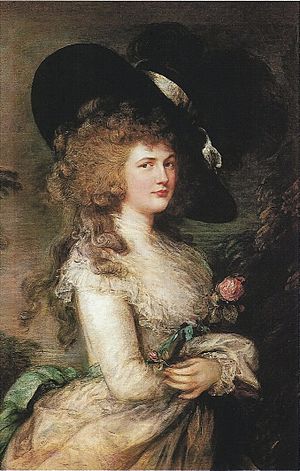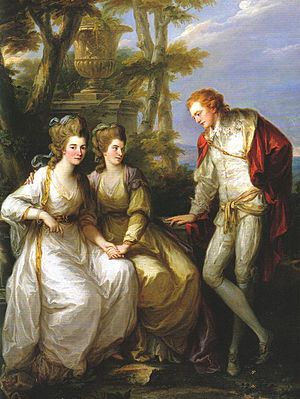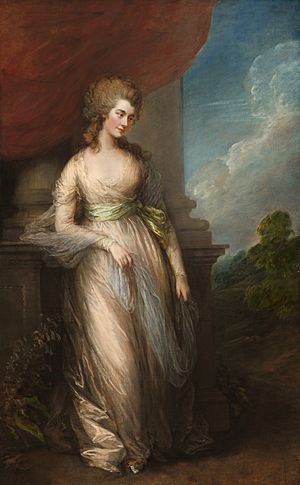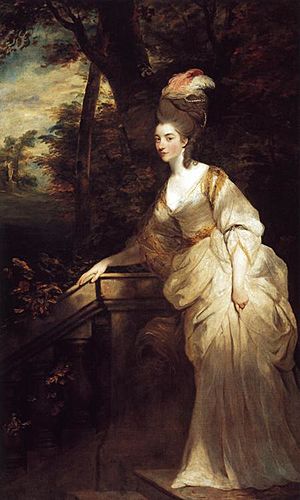Georgiana Cavendish, Duchess of Devonshire facts for kids
Quick facts for kids
The Duchess of Devonshire
|
|
|---|---|

Portrait by Thomas Gainsborough
(18th century) |
|
| Born | Georgiana Spencer 7 June 1757 Althorp, Northamptonshire, England |
| Died | 30 March 1806 (aged 48) Devonshire House, Westminster, London, England |
| Buried | Derby Cathedral, Derbyshire |
| Noble family | Spencer (by birth) Cavendish (by marriage) |
| Spouse(s) |
William Cavendish, 5th Duke of Devonshire
(m. 1774) |
| Issue |
|
| Father | John Spencer, 1st Earl Spencer |
| Mother | Margaret Georgiana Poyntz |
| Occupation |
|
Georgiana Cavendish, Duchess of Devonshire (born Georgiana Spencer; 7 June 1757 – 30 March 1806), was a famous English socialite and activist. She was born into the noble Spencer family and later married into the Cavendish family. She was the first wife of William Cavendish, 5th Duke of Devonshire, and the mother of the 6th Duke of Devonshire.
As the Duchess of Devonshire, she became very famous in society. She was known for her charm, political influence, beauty, and love for social events. People often compare her life to that of her distant relative, Diana, Princess of Wales, because both faced a lot of public attention.
Contents
Early Life and Family

Georgiana Spencer was born on 7 June 1757. She was the first child of John Spencer and his wife, Georgiana. Her family home was Althorp, in England. Her mother loved her very much and wrote that she would "never love another so well."
Georgiana had two younger siblings: Henrietta and George. Her father came from a very rich noble family. He built a large home in London, where Georgiana and her siblings grew up happily. Georgiana was especially close to her mother.
When her father became Viscount Spencer in 1761, Georgiana became "The Honourable Georgiana Spencer." In 1765, he became Earl Spencer, and she became "Lady Georgiana Spencer."
Marriage and Children

On her 17th birthday, 7 June 1774, Lady Georgiana Spencer married William Cavendish, 5th Duke of Devonshire. He was 25 and considered the most eligible bachelor in society. The wedding was a small ceremony. Georgiana's parents were sad to see her go, but she was marrying one of the wealthiest and most powerful men in the country. Her father wrote to her, saying he missed her "more every day and every hour."
From the start, the Duke was a quiet and reserved man. He was very different from Georgiana's loving father and didn't always understand her feelings. They didn't have much in common, and the Duke often spent his evenings playing cards.
Before their marriage, the Duke had a daughter named Charlotte Williams. Georgiana didn't know about Charlotte until years later. After Charlotte's mother passed away, Georgiana took on the role of raising Charlotte. She loved Charlotte very much, even though her own mother was a bit unsure about it.
In 1782, Georgiana met Lady Elizabeth Foster, known as "Bess," in the city of Bath. Bess had separated from her husband and was struggling. Georgiana and Bess became very close friends. With the Duke's agreement, Bess came to live with them permanently.

Georgiana had her first child, a daughter named Lady Georgiana Dorothy Cavendish, on 12 July 1783. She was called "Little G." Georgiana insisted on nursing her own children, which was unusual for noblewomen at the time. On 29 August 1785, she had another daughter, Lady Harriet Elizabeth Cavendish, called "Harryo."
Finally, on 21 May 1790, Georgiana gave birth to a son, William George Spencer Cavendish. He was known as "Hart" and would later become the 6th Duke of Devonshire.
Georgiana also had another daughter, Eliza Courtney, born on 20 February 1792. Georgiana was not able to raise Eliza herself, but she visited her often and gave her gifts and affection.
Character
Georgiana was known for being generous, charming, and intelligent. She had a good sense of humor and was kind-hearted. From a young age, she loved to help others, often giving money to poor children or her friends. She even showed kindness to animals. Once, she saw a starving cow and found its owner to give him money to feed it.
Even though she was very self-conscious, Georgiana always seemed natural and at ease, even when she was the center of attention. She could talk to many people at once and make each person feel special. Most people found it almost impossible not to like Georgiana.
Interests and Fame
With her unique beauty and kind personality, along with her marriage to the powerful Duke of Devonshire, Georgiana was like the Diana, Princess of Wales of her time. Her popularity with the public and the press was similar to what Diana experienced centuries later. Just like Diana, Georgiana's every move was watched and reported on, and her mistakes were often made fun of in the newspapers.
Georgiana was also a major fashion icon in England. Whatever she wore, including her hairstyles, was quickly copied by many people. Her tall, elaborate hairstyles were especially famous.
Using her influence as a leading socialite and fashion trendsetter, Georgiana also contributed to politics, science, and literature. She often hosted gatherings called "salons" where important writers and politicians would meet. Her friends included the Prince of Wales (who later became King George IV) and Marie Antoinette, the Queen of France.
Politics
Georgiana's family, the Spencers, strongly supported the Whig party, and so did she and the Cavendish family. Because her husband, the Duke, had a very high position that limited his direct involvement in politics, Georgiana became very active herself. At a time when women had very few rights, she became a political activist. She was one of the first women to openly and powerfully participate in politics.
She started her political involvement in 1778, inspiring many women to support the Whig party. She believed in ideas of liberty and freedom and campaigned for Whig leaders like Charles James Fox. The Whigs were against too much power for the monarchy and supported people's rights.
During the 1784 British general election, Georgiana became a big target for criticism. Rumors and political cartoons made fun of her, suggesting she traded kisses for votes. Her mother asked her to stop, but Georgiana was determined. On election day, she walked the streets of London, meeting ordinary people face-to-face. She played a key role in helping her chosen candidates win. After the election, she stepped back from public campaigning for a while but continued her political work behind the scenes. She even tried to help rebuild the Whig party later in her life.
Literature
Georgiana was also a keen writer and wrote several poems and stories, some of which were published. As a young girl, she wrote poems for her father.
Her first published work was a novel called Emma; Or, The Unfortunate Attachment: A Sentimental Novel in 1773. In 1778, another novel, The Sylph, was released anonymously, but Georgiana later admitted she wrote it. The Sylph was very successful and was reprinted four times.
One more important work was published later in her life, a poem called The Passage of the Mountain of Saint Gothard (1799). This poem was dedicated to her children and was based on her journey through the Gotthard Pass in Switzerland. It was translated into several European languages. Famous writer Samuel Taylor Coleridge even wrote a poem praising Georgiana's work.
Georgiana knew many important writers of her time. The famous writer Samuel Johnson even visited her and the Duke at their home, Chatsworth House.
Science
Georgiana had a small laboratory where she did chemistry experiments. She also studied geology, natural history, and especially loved mineralogy (the study of minerals). She was interested in science partly because she was related by marriage to the chemist Henry Cavendish, whose lab she visited.
She often discussed science with leading scientists of her time. Her knowledge of chemistry and mineralogy was considered brilliant. Scientists like Thomas Beddoes and Henry Cavendish were impressed by her understanding and observations. To pursue her interest, she even hiked to the top of Mount Vesuvius to study its active crater. She also started the Devonshire Mineral Collection at Chatsworth House.
Georgiana also helped create the Pneumatic Institution in Bristol with Thomas Beddoes. This institute helped advance the study of gases, which was important for the development of modern anesthesia and biomedical research.
Later Life and Death
After returning to England, Georgiana continued her interest in science and writing. She also tried to help rebuild the Whig party, though her efforts were not successful before her death.
In 1796, she became ill in one eye, and the medical treatment left a scar on her face. In her early forties, she focused on introducing her eldest daughter, Lady Georgiana Dorothy Cavendish, to society. Her daughter married Lord Morpeth in 1801.
Georgiana's health continued to get worse. She passed away on 30 March 1806, at the age of 48. Her husband, mother, sister, eldest daughter, and Lady Elizabeth Foster were all with her and were very sad. Thousands of people gathered in London to mourn her death. She was buried at Derby Cathedral.
Legacy

After Georgiana's death, the Duke of Devonshire married Lady Elizabeth Foster. Georgiana's children were not happy about this marriage because they never liked Lady Elizabeth. When the 5th Duke died in 1811, Georgiana's son, Hart, became the 6th Duke. He eventually settled things with Lady Elizabeth. Georgiana's children remained close with Lady Elizabeth Foster's children, as they had grown up together.
In 1786, the bestselling author Susanna Rowson dedicated her first book, Victoria, to the Duchess of Devonshire.
Georgiana's brave involvement in politics helped pave the way for women to participate more openly and powerfully in public life. This was long before women gained the right to vote or the start of the feminist movement.
Many famous paintings of the Duchess of Devonshire from her time still exist, including a 1787 portrait by the well-known artist Thomas Gainsborough. More than 1,000 of her personal letters are also still preserved, mostly at Chatsworth House, the Duke of Devonshire's main home.
Film Portrayals
- The Divine Lady (1929), played by Evelyn Hall
- Berkeley Square (1933), played by Juliette Compton
- The House in the Square (1951), played by Kathleen Byron
- The Duchess (2008), played by Keira Knightley. This movie was based on a book about Georgiana's life.
Opera Pasticcio
- Georgiana (2019), an opera created for the 40th anniversary of the Buxton Festival.
Works by Georgiana Cavendish
- Emma; Or, The Unfortunate Attachment: A Sentimental Novel (1773)
- The Sylph (1778)
- The Passage of the Mountain of Saint Gothard (1799)
Images for kids
-
The Duchess of Devonshire by Lady Diana Beauclerk, around 1779
-
The Duchess of Devonshire by John Downman, around 1780
-
The Duchess of Devonshire by Joshua Reynolds, around 1780–81
-
The Duchess of Devonshire by Joshua Reynolds, 1786
See also
 In Spanish: Georgiana Cavendish para niños
In Spanish: Georgiana Cavendish para niños





